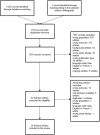Predictive Factors for Successful Decannulation in Patients with Tracheostomies and Brain Injuries: A Systematic Review
- PMID: 38189928
- PMCID: PMC11239766
- DOI: 10.1007/s00455-023-10646-2
Predictive Factors for Successful Decannulation in Patients with Tracheostomies and Brain Injuries: A Systematic Review
Abstract
Neurological patients frequently have disorders of consciousness, swallowing disorders, or neurological states that are incompatible with extubation. Therefore, they frequently require tracheostomies during their stay in an intensive care unit. After the acute phase, tracheostomy weaning and decannulation are generally expected to promote rehabilitation. However, few reliable predictive factors (PFs) for decannulation have been identified in this patient population. We sought to identify PFs that may be used during tracheostomy weaning and decannulation in patients with brain injuries. We conducted a systematic review of the literature regarding potential PFs for decannulation; searches were performed on 16 March 2021 and 1 June 2022. The following databases were searched: MEDLINE, EMBASE, CINAHL, Scopus, Web of Science, PEDro, OPENGREY, OPENSIGLE, Science Direct, CLINICAL TRIALS and CENTRAL. We searched for all article types, except systematic reviews, meta-analyses, abstracts, and position articles. Retrieved articles were published in English or French, with no date restriction. In total, 1433 articles were identified; 26 of these were eligible for inclusion in the review. PFs for successful decannulation in patients with acquired brain injuries (ABIs) included high neurological status, traumatic brain injuries rather than stroke or anoxic brain lesions, younger age, effective swallowing, an effective cough, and the absence of pulmonary infections. Secondary PFs included early tracheostomy, supratentorial lesions, the absence of critical illness polyneuropathy/myopathy, and the absence of tracheal lesions. To our knowledge, this is the first systematic review to identify PFs for decannulation in patients with ABIs. These PFs may be used by clinicians during tracheostomy weaning.
Keywords: Acquired brain injury; Decannulation; Predictive factors; Rehabilitation; Tracheostomy weaning.
© 2024. The Author(s).
Conflict of interest statement
The authors have no competing interests to declare that are relevant to the content of this article.
References
-
- Durbin CGJ. Tracheostomy: why, when, and how? Respir Care. 2010;55(8):1056–1068. - PubMed
Publication types
MeSH terms
LinkOut - more resources
Full Text Sources


